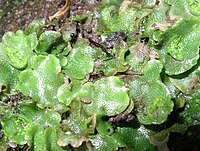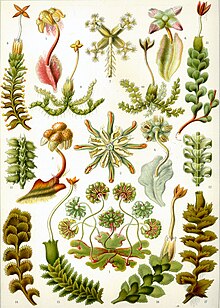Liverwort
The liverworts are a group of simple plants. Scientists believe that liverworts were the first bryophyte to evolve. They believe that mosses, hornworts, and more complex plants then evolved from liverworts. Scientists decided this from mitochondrial DNA.[1]p75


| Liverworts | |
|---|---|

| |
| "Hepaticae" from Ernst Haeckel's Kunstformen der Natur, 1904 | |
| Scientific classification | |
| Kingdom: | Plantae |
| Clade: | Embryophytes |
| Clade: | Setaphyta |
| Division: | Marchantiophyta Stotler & Stotl.-Crand., 1977[3] emend. 2000[4] |
| Classes and orders | |
Liverworts are usually placed in the bryophytes, a group of plants without tissue to conduct water. That is why they always need to live near a spring, a river, or in a place where there is a lot of fog or has a lot of rainfall. This group also includes with mosses and hornworts. Recent taxonomy gave them their own division called the Marchantiophyta. However, since the classification is not yet settled, we use the old terms.
Liverworts, as the picture shows, are small plants with flattened bodies, or with flattened stems bearing overlapping scales.[5]p135
The name liverwort comes from the Middle Ages, when plants were selected as medicines according to the false belief that similia similibus curentur (similar heals similar). The liver shape seen in the liverwort Marchantia, for example, was boiled in wine as a medicine against liver problems. The name was then transferred to the whole group.
Reproduction
changeLiverworts have a gametophyte-dominant life cycle. This means that most parts of them only have one copy of DNA, like mosses. In most plants and animals, most parts have two copies of DNA. Some parts of liverworts have two copies, and they're called the sporophytes. These are stalks that grow sporangia, sacs with spores inside. They're simple, and don't last long.
References
change- ↑ Willis K.J. and McElwain J.C. 2002. The evolution of plants. Oxford.
- ↑ Cite error: The named reference
Walker 2010was used but no text was provided for refs named (see the help page). - ↑ Stotler, Raymond E.; Barbara J. Candall-Stotler (1977). "A checklist of the liverworts and hornworts of North America". The Bryologist. 80 (3). American Bryological and Lichenological Society: 405–428. doi:10.2307/3242017. JSTOR 3242017.
- ↑ Crandall-Stotler, Barbara; Stotler, Raymond E. (2000). "Morphology and classification of the Marchantiophyta". In A. Jonathan Shaw; Bernard Goffinet (eds.). Bryophyte Biology. Cambridge: Cambridge University Press. p. 21. ISBN 0-521-66097-1.
- ↑ Schofield W.B. 1985. Introduction to Bryology Macmillan, New York. ISBN 0-02-949660-8.